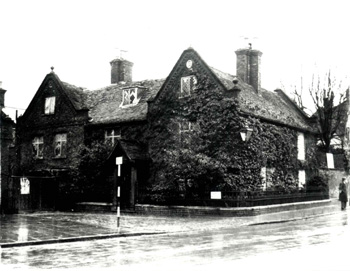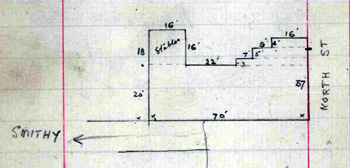
Holly Lodge shortly before demolition about 1968 [Z50/72/209]
The Manor of Leighton Buzzard alias Grovebury was the principal landowner in the town before the 19th century. Bedfordshire & Luton Archives & Records Service has a full run of court rolls from 1393 to 1727 [KK619-715] and another full run from 1704 to 1867 [X288/1-23]. The service also has court rolls for other manor to own land in the town, the Prebendal Manor, from 1448 to 1459, 1588 to 1591, 1611 to 1622, 1627 and 1631 [KK792-1798]. A fair number of buildings in North Street were originally copyhold and a detailed study of these court rolls would probably produce quite detailed histories for a number of properties and the sites on which they stand, though it would take many years of study.
Holly Lodge, also called The Hollies, was built in 1607. Some notes on Holly Lodge were put together by Bedfordshire & Luton Archives & Records Service staff in 1958 [CRT130Lei9]. At the time of Benjamin Bevan's 1819 map and 1821 reference book the property was owned by J. Clarke and occupied by himself and Miss Walker. It was a copyhold property. A James Clarke, innkeeper, also owned the Plume of Feathers in 1821 and, in his will of 1829, proved 1830, left all his property to be divided between his children Joseph, John, Jeremy and Gregory Odell Clarke and his two married daughters. The notes speculated: "One of the sons, Jeremy, had helped him in his business as an innkeeper, and it may be that Jeremy was the J. Clarke occupying the Plume of Feathers at the time of Bevan's survey, and that James was then living in retirement at Holly Lodge, for James had appeared as early as 1798 on Jury Lists as a maltster".

Stairs at Holly Lodge shortly before demolition [Z50/72/213]
At the time of the 1840 Tithe Award the house was owned and occupied by Jeremy Clarke, and is described as "Homestead and Garden". In an 1839 Directory Jeremy Clarke of North Street was described as a maltster, and also in 1850. In 1854 and 1869 Jeremy Clarke, maltster, appears but with no address. In the 1871 census 76 year old Jeremy Clarke, retired maltster lived in North Street with his nephew and wife and a male servant. The position vis-à-vis the Black Horse is consistent with this being Holly Lodge. He does not appear in a directory for 1877 and so was presumably dead by then.
The Luton News of 1st October 1914 tells us about Belgian refugees from the German invasion which had sparked the First World War: "Thanks to the initiative and energy of Mrs. W. Gravely W. Willis, a party of Belgian refugees are now comfortably established at "The Hollies", North-street, Leighton Buzzard - a large house standing in a commanding position which has generously been allowed to be used rent free for the purpose of providing a home for some of these people. The party consists of people who were formerly in lucrative and honoured position in Belgium, but who are now dependant for the time bing on the charitable disposition of the British public for homes, and the very mens of maintaining an existence - this through the "culture" and greed of the Germans for world power. At Leighton the refugees are being well looked after, and so enthusiastically has Mrs. Willis and her several lady assistants worked that the house is particularly comfortably furnished. the furniture and household requisites have been lent by friends in Leighton whose response to the appeals made on behalf of the refugees have been most ready and gratifying. So satisfactory, indeed, has the response been that, although gifts in kind and money would be gratefully received, Mrs. Willis is now only in need of household linen to complete her arrangements for the comfort of the guests at "The Hollies"".
"At present there is a family of five quartered at "The Hollies". They arrived yesterday (Wednesday) but more will be established there in a few days".

Valuer's plan of The Hollies 1927
Under the terms of the Rating and Valuation Act 1925 every piece of land and building in the country was assessed to determine the rates to be paid on them. Leighton Buzzard was assessed in 1927 and the valuer visiting Holly Lodge discovered that it was owned by Miss B. C. Hopwood [who wrote thrillers under he name of Patrick Leyton] and occupied by her and Miss I. C. Morris. The valuer commented: "Very old Tudor House. Nice inside, but poor position. No grounds to house. Smithy and warehouses adjoining. Small garden".
The ground floor comprised a drawing room, dining room, lounge hall, kitchen, scullery and parlour. Four bedrooms and a bathroom and W. C. lay on the first floor with three attic stores above. A small greenhouse and a brick and slate stable with a loft over stood outside. The valuer commented: "need for coal shed etc."

Rear of Holly Lodge shortly before demolition [Z50/72/211]
The house was, like the other old house in the town whose age and fate it shared, the Maidenhead in Lake Street, requisitioned in World Ward Two having been empty since 1936. The house was then used by the Leighton Buzzard Co-operative Society for storage. Sir Nikolaus Pevsner in his Buildings of England volume for Bedfordshire of 1968 described Holly Lodge thus: "the most impressive house of Leighton Buzzard and hence, as so often, derelict. Blue and red brick. Centre and two cross gables; later 17th century". He would no doubt have not been surprised to hear of Holly Lodge's demolition to make way for West Street not long afterwards.